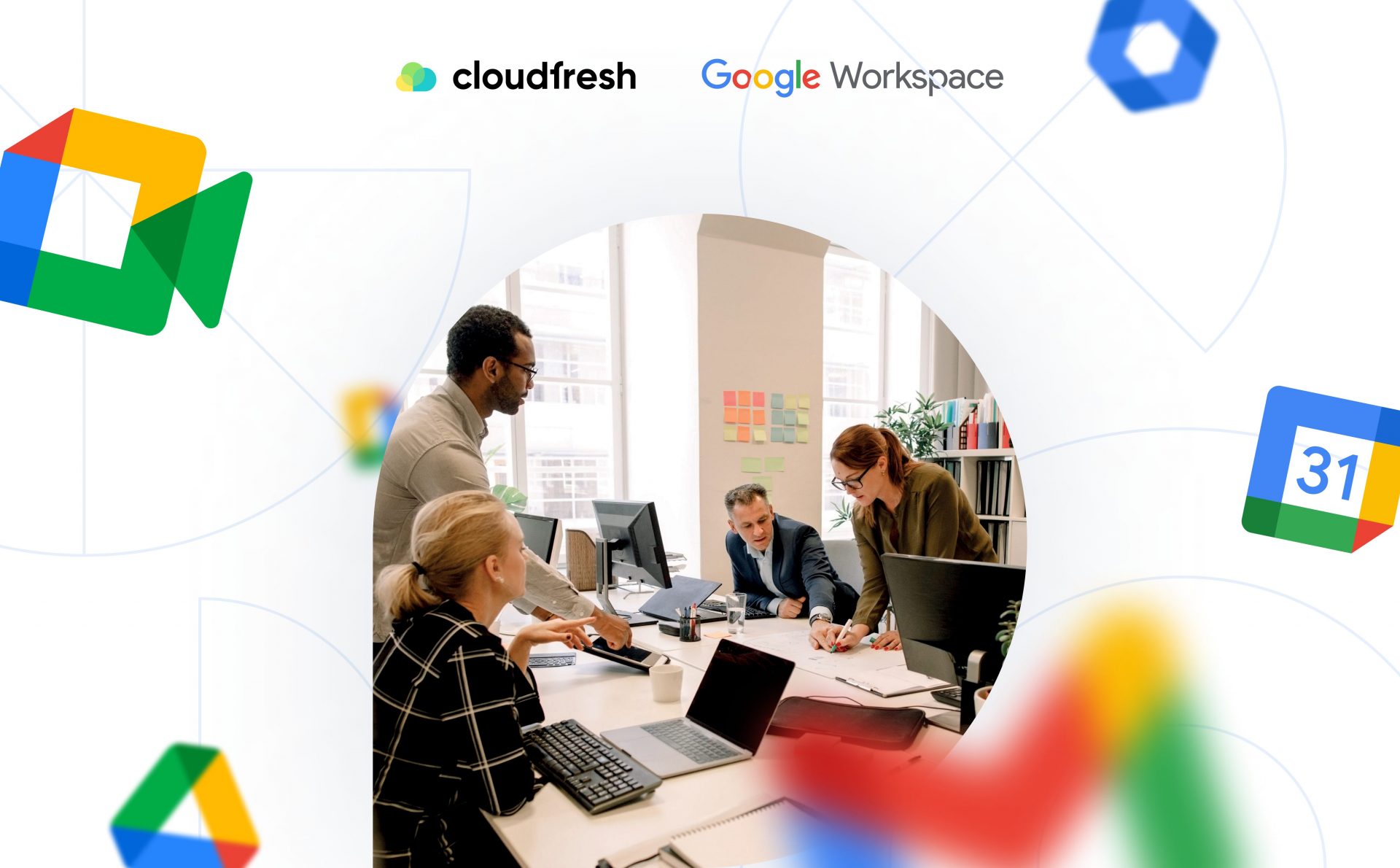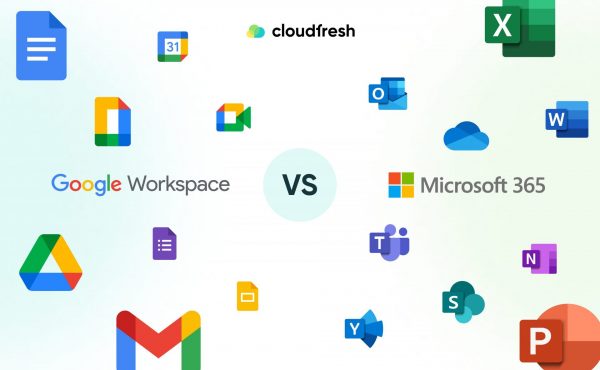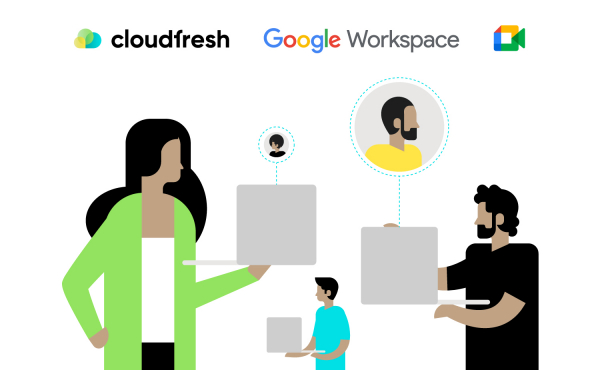Google Workspace vs Microsoft 365
Google Workspace Pricing Plans in 2025
- Google Workspace Plans: Price Ranges
- Google Workspace Plans’ Functionalities
- Which Google Workspace Pricing Plan Is Right for You in 2025?


Businesses worldwide struggle to make their teams the most flexible and efficient while bracing for the upcoming challenges and dealing with the challenges of today. Therefore, the solutions that permit teams of all sizes to stay connected, create content, and work together are of current interest in most organizations.
One robust solution that can unite your team and allow you all to work effectively from any device and any place is Google Workspace (formerly G Suite). It is a flexible, innovative solution that helps people and organizations achieve more.
In this article, we would like to highlight the differences between 2025 Google Workspace pricing plans (from now on, GWS) to alleviate your choice and to ensure you select the plan according to your business needs.
Google Workspace Plans: Price Ranges
Currently, there are four different Google Workspace price and functionality options:
- Business Starter: USD 7.20 (billed monthly) / USD 6.00 (billed annually) per user per month.
- Business Standard: USD 16.80 (billed monthly) / USD 14.00 (billed annually) per user per month.
- Business Plus: USD 26.40 (billed monthly) / USD 22.00 (billed annually) per user per month.
- Enterprise: to request a quote, please contact our sales team.
Companies with up to 300 users can purchase Business Starter, Business Standard, and Business Plus plans. Enterprise plans have no minimum or maximum number of users.
All the plans are straightforward, so it is easy to choose according to the list of functional differentiators. GWS gives its users comprehensible pricing options—that is, flexible and commitment-based—with the possibility to switch between the two. Regarding the defined costs of each plan, forecasting how much GWS will cost for your business and which plans will suit your company budget the most is also a piece of cake.
Google Workspace Plans’ Functionalities
All Google Workspace pricing plans offer an ability to set up personalized corporate email addresses and access collaboration tools like Gmail, Calendar, Meet, Chat, Drive, Docs, Sheets, Slides, Forms, Sites, and more. Read our new how-to guide to learn about Gmail hacks and tricks.
While all GWS pricing plans have a secure email with corporate addresses, the Business Standard and Plus plans also enable customers to sign electronic documents and collaborate in a video editor. The Enterprise plan, having all the Business Plus features, also gives you the Secure/Multipurpose Internet Mail Extensions (S/MIME) for additional message protection.
One of the most popular GWS features is the advanced meetings experience possible with Google Meet. Here, the differentiation among the plans is simple: the Business Starter and Business Standard pricing plans allow you to host meetings with up to 100 and 150 participants, respectively, along with a possibility of recording. At the same time, Business Plus allows more than 500 participants, video recording, attendance tracking, and noise cancellation. The Enterprise plan gives you all the Business Plus features and also makes it possible to hold meetings for 1,000 participants and broadcast live for users within the corporate domain.
The next, but not less important, difference between Google Workspace pricing plans is the storage capacity.
- Business Starter: 30 GB of pooled storage space per user.
- Business Standard: 2 TB of pooled storage space per user.
- Business Plus: 5 TB of pooled storage space per user.
- Enterprise: 5 TB with the ability to request as much memory as you need.
All Google Workspace pricing plans have specific security and management features providing users with two-step verification, group management rules, additional protection programs, and others. Business Plus users can also take advantage of the Google Workspace Migrate tool—which allows migration of large amounts of data for saving, archiving, and searching—as well as the Vault, advanced endpoint management, and a number of other features. Whereas in the Enterprise plan, the users will get many more tools, achieving the highest level of work environment security and data protection, such as Data Leak Prevention (DLP), Cloud Identity Premium, and many others. As AI is seemingly taking over the world, it’s also worth noting that almost all Google Workspace plans come with Gemini Advanced and NotebookLM Plus (except Business Starter, for which there are limited versions).
Every Google Workspace pricing plan enables customers with standard support. When on Business Starter, users get regular customer service, which implies P1 request processing within four hours, 24/7 support for P1-level requests, and multi-channel support. At the same time, the Business Standard and Plus users, who are also provided with standard support, can do a paid extension. With the extended support, besides all standard support features, the customers get highly qualified product technicians and support for third-party technologies.
Only one Google Workspace pricing plan includes extended support from the get-go—the GWS Enterprise. Here, the users can further upgrade their extended support to Premium and get individual customer support, training for their teams, and other perks available exclusively on this plan. Cloudfresh specialists also provide clients with GWS services, support, and training for the teams, offering various types of Professional Service Packages. Please connect with our certified Google Workspace consultants to learn more about available offerings.
Which Google Workspace Pricing Plan Is Right for You in 2025?
With such vast and diverse functions, it is quite fair to be wondering which Google Workspace pricing plan would best suit your business size, needs, and purposes.
Based on the lists of features of different Google Workspace plans, GWS Business Starter is most relevant to organizations that have small-size teams with five or fewer members. This plan is most suitable for a business that needs a corporate domain with essential security and management features but does not need much storage space.
The Business Standard and Business Plus plans are pertinent for medium to large organizations that need a large amount of storage, a more advanced meetings experience (e.g., appointment booking pages) with a greater number of attendees, and extra features. These GWS plans also suit the companies who want to obtain a higher level of security, admin controls, work with data, or even take the opportunity of extending their support (if needed). If you are fully aware of each and every one of your organization’s needs, then it’s better to choose between these two Google Workspace plans and learn more about their features.
And finally, the GWS Enterprise plan speaks for itself. It is the best productivity and collaboration solution for large organizations. This plan will give you strong security features, data protection, the most qualified meetings experience, unlimited storage amount, and many other essential components to build out the most effective, secure, and stable environment.
Feeling overwhelmed? Below, you can find a cheat sheet aiming to help you make an informed decision regarding a fitting Google Workspace pricing plan.
1. Team Size and Needs
- Number of users: How many people will need access to Google Workspace?
- Required features: Do you want your team to use Gmail, Calendar, Drive, Docs, Sheets, Slides, Meet, Chat, or more?
2. Budget
- Google Workspace cost per user: How will different plans affect your organization’s budget?
- Additional costs: How much does Google Workspace cost, provided that you require increased storage or advanced features?
3. Scalability
- Future growth: What’s your organization’s expected growth? Will the chosen plan be able to accommodate future needs?
- Flexibility: Does the plan in question offer flexibility to upgrade or downgrade as your requirements change?
4. Security and Compliance
- Data security: Does the plan come with the security features you need? Think of data encryption, access controls, and compliance certifications.
- Industry-specific requirements: Does your organization (for example, if you’re in healthcare, finance, or education) have any unique, stringent compliance needs?
5. Support and Administration
- Support options: Is the level of support sufficient? Does the plan offer adequate assistance?
- Administrative tools: How easy is it to manage user accounts, permissions, and settings for your organization?
6. Integration with Existing Systems
- Compatibility: Can Google Workspace really integrate with your existing systems and workflows without a hitch?
You are more than welcome to get in touch with our experts if you wish to find out which Google Workspace pricing plan would be the perfect match for your business.
Being a global Google Cloud Premier Partner with a Work Transformation specialization, Cloudfresh can not only help you compare Google Workspace plans but also provide you with the following services:
- PoC.
- Implementation.
- Custom Development.
- Migration.
- Integration.
- Training.
- Licensing.
- Support.
- AI Adoption.












